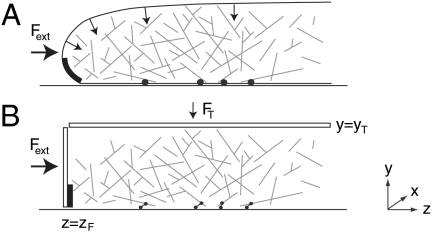Fig. 1.
Model lamellipod. (A) Schematic drawing of a lamellipod, illustrating the basic physical assumptions of our model. The slight curvature of the membrane on the upper surface of the lamellipod generates forces (arrows) due to surface tension that constrain the actin gel. The Arp2/3 complex mediates filament branching when it is in the proximity of the highly curved section on membrane at the base of the leading edge, marked in black. Filaments close to the substrate can form transient adhesions (●). (B) Simplified geometry of the model. A small vertical force FT mimics the forces due to membrane surface tension. Filament branching can occur in the cuboid region marked in black. An external force Fext applied to the leading edge is balanced by the reactive force due to adhesions (which are represented as springs).

